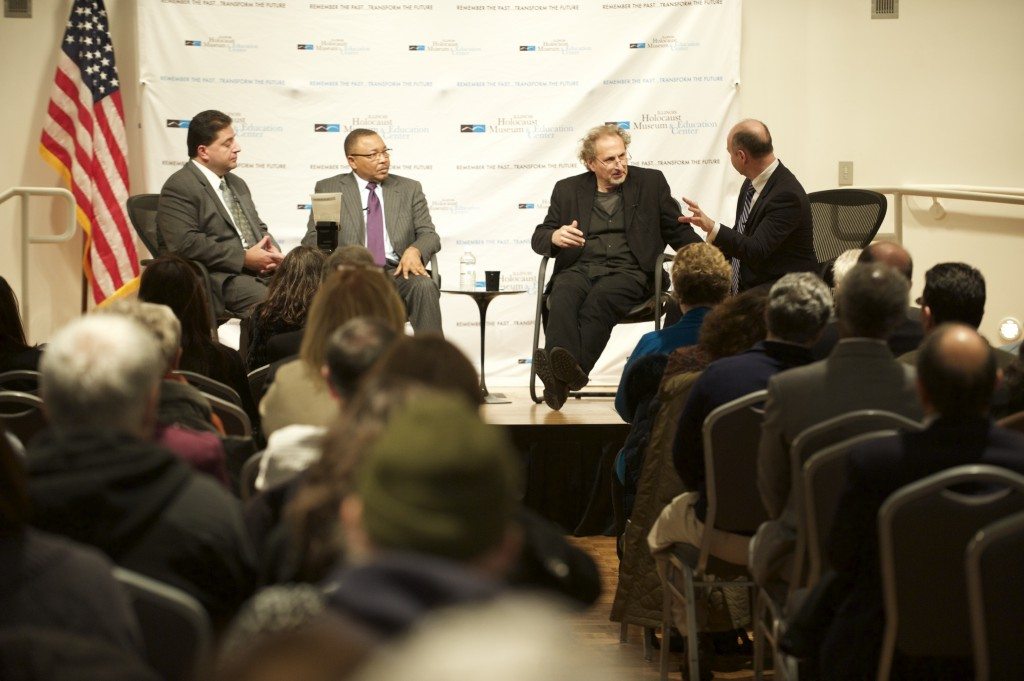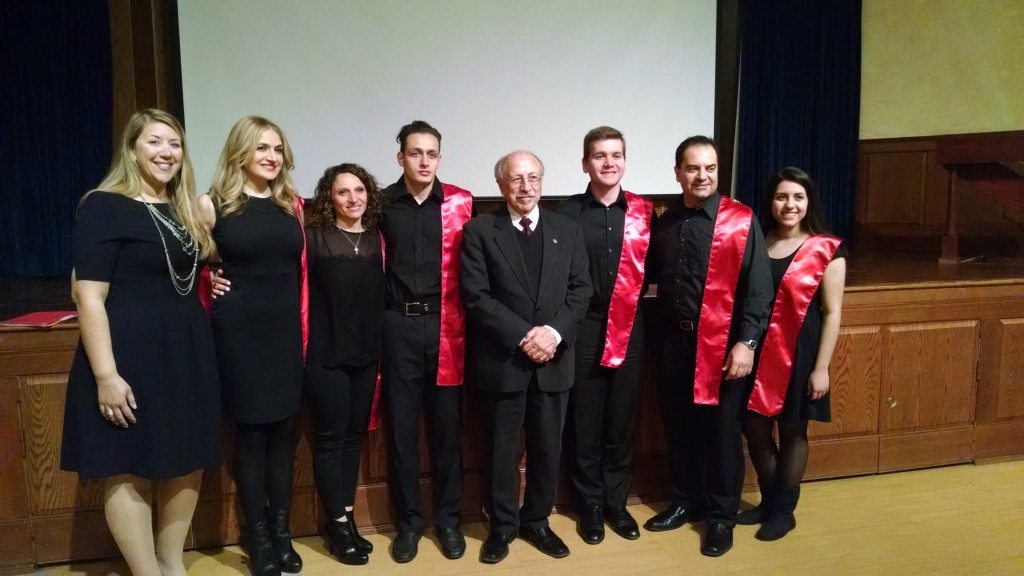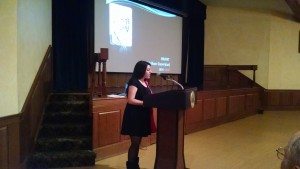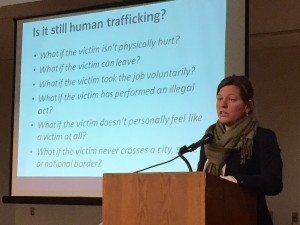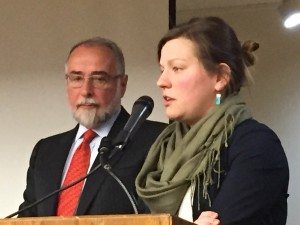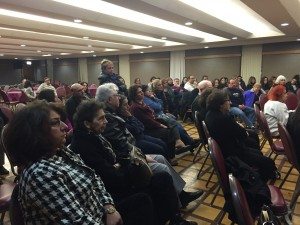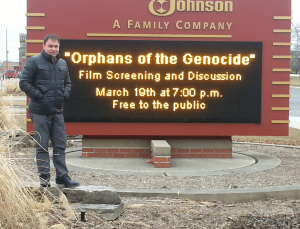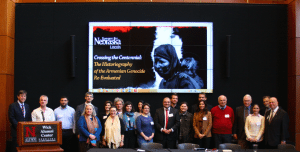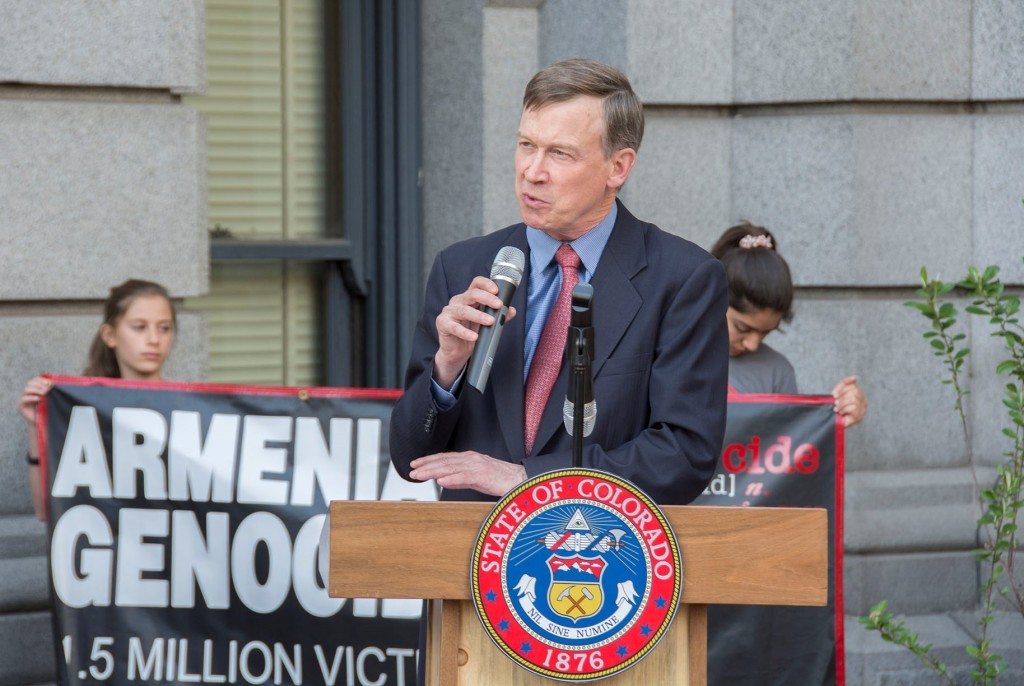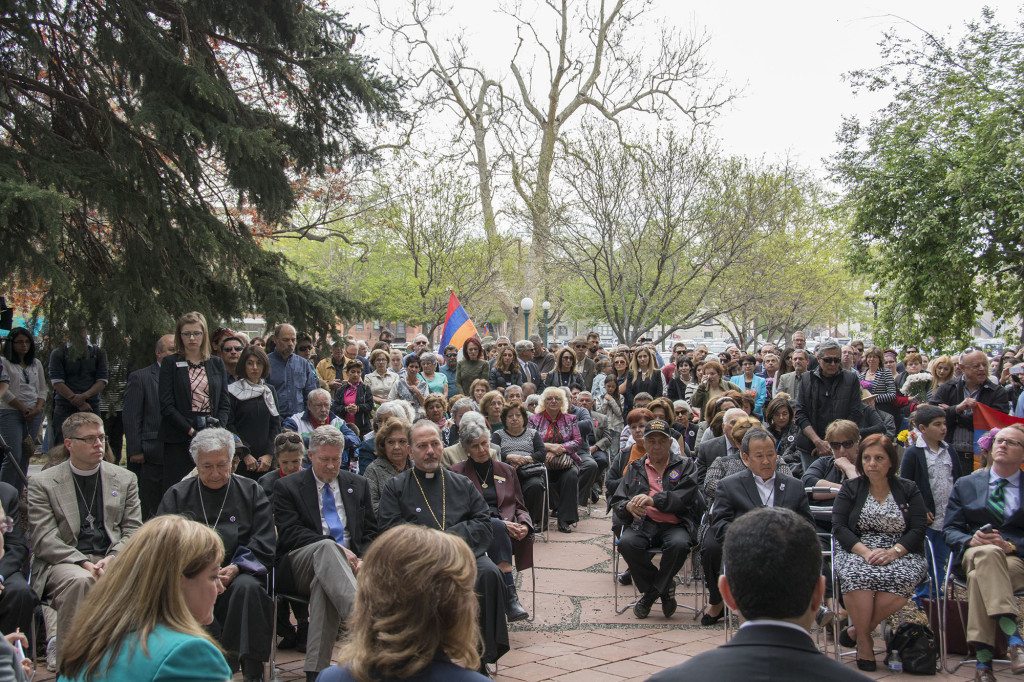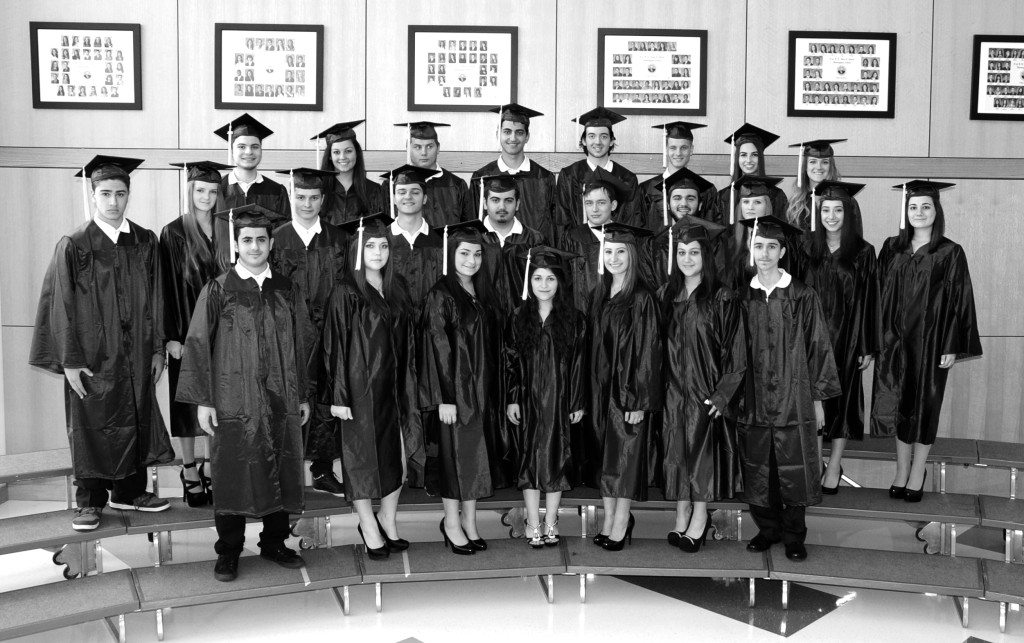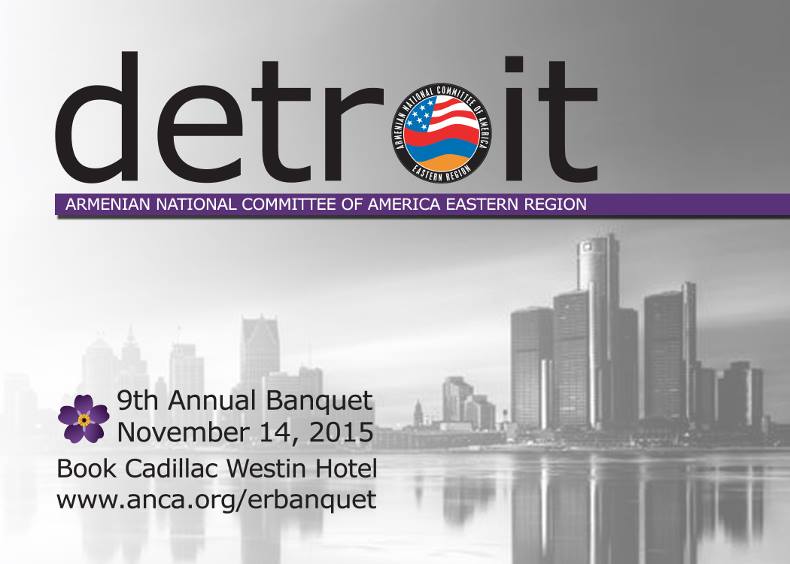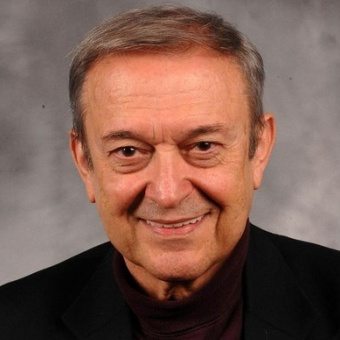LINCOLN, Neb.—On the occasion of the Centennial of the Armenian Genocide, the University of Nebraska-Lincoln (UNL) on March 19-20 hosted a two-day international conference entitled, “Crossing the Centennial: The Historiography of the Armenian Genocide Re-Evaluated,” at the Wick Alumni Center, Great Hall, in Lincoln. Organized by Prof. Bedross Der Matossian from UNL’s Department of History, the conference was sponsored by the Norman and Bernice Harris Center for Judaic Studies, the National Association for Armenian Studies and Research (NAASR), the Society for Armenian Studies (SAS), the Department of History, the Faculty Senate Convocation Committee, the Human Rights and Humanitarian Affairs Program, the Women’s and Gender Studies Program, and the Institute of Ethnic Studies at UNL.
![Participants of 'Crossing the Centennial' conference]()
Participants of ‘Crossing the Centennial’ conference
The conference focused on four under-researched themes that have recently gained scholarly attention and analytical depth: humanitarianism and humanitarian intervention in the Armenian Genocide; women and children in the Armenian Genocide; comparative dimensions of the Armenian Genocide; and the impact of the Armenian Genocide on society, politics, literature, and culture. Seventeen scholars from Armenia, Cambodia, Canada, Holland, Hungary, Israel, and the United States participated in the conference.
On March 19, the chair of the History Department, Prof. William G. Thomas III, offered welcoming remarks in which he emphasized the commitment of the department to teaching and research of the field of Holocaust and genocide studies. Der Matossian then made opening remarks in which he gave a brief background about the Armenian Genocide and highlighted the importance of commemorating the Centennial in the academic sphere. Der Matossian criticized the latest trend of denialism surging in the academic sphere, saying, “Despite the fact that over the course of the past two decades, the historiography of the Armenian Genocide has evolved through the introduction of new methodologies, approaches, and more complex analyses of the genocide that venture beyond rudimentary and essentialist arguments and representations, denial of the Armenian Genocide has also gained new ground by using the academic sphere.”
Following Der Matossian’s remarks, the first panel, entitled, “Humanitarian Intervention and Humanitarianism,” began. Chaired by Prof. David Forsythe from UNL, it featured three papers. The first paper, entitled, “Humanitarian Intervention and Ottoman Opposition to Extermination: A Neglected Aspect,” was delivered by Dr. Hilmar Kaiser (Cambodia). Kaiser detailed the unique situation of the Ottoman Fourth Army in the Armenian Genocide and the role of Djemal Pasha, as the area under their control saw a significantly lower death toll than other regions of the empire. By 1918, relief workers, consular staff, and Ottoman oppositional circles had kept alive the majority of Armenian survivors within the empire, argued Kaiser. According to him, notions of a unified Ottoman administration or CUP are obsolete. He suggested that a better understanding is needed to distinguish between CUP factions advocating repressive or genocidal policies. Kaiser’s paper was based on his latest findings from the Ottoman archives, and Western archives while focusing on the period before the Der Zor massacres.
The next paper, “Armenian Refugees, Humanitarian Assistance and Hungary,” was delivered by Péter Pál Kránitz (Pázmány Péter Catholic University). In his paper, Kránitz demonstrated how the Hungarian government took part in the process of the international protection and support of the Armenian refugees of the genocide within the framework of the League of Nations and by its internal jurisdiction. He discussed how Hungarian diplomacy committed itself to improving the efficiency of the Nansen passport system, defining the quantity and the situation of Russian and Armenian refugees, and facilitating the transportation and integration of the refugees.
Following Kranitz, Prof. Mark Toufayan (University of Ottawa) gave the last paper of the first panel. Entitled “Between Intimacy and Alienation: Armenian Property, Denationalization and the Passions of ‘Protection’ in French Mandated Cilicia, 1918-23,” Toufayan’s paper discussed from a legal perspective the ambivalent relationship between French humanitarian efforts and the country’s economic interests. He argued that “far from resisting a form of economic imperialism, a politics of compassion and care for Armenian suffering in the aftermath of genocide was, in fact, central to population policies in the Near East by harnessing them to the political economy of European capitalism. At the same time, humanitarian discourse could be mobilized to reinforce economic inequalities between and amongst Armenians, French, and Turks on either side of the debates about the legality of the confiscations, thus entrenching, rather than opposing, colonialist and nationalist bourgeois utopian state-building projects.”
The second—and featured—panel was moderated by Prof. Jean Cahan, the director of the Harris Center for Judaic Studies, and included three speakers. Prof. Richard G. Hovannisian (University of California-Los Angeles) gave a passionate and a powerful talk entitled, “The Centenary of the Armenian Genocide: What Have We Learned?” Hovannisian recounted his family history and the way in which he encountered the Armenian Genocide. He focused on his experience of growing up with genocide survivors and discussed the developments that have taken place in the field of the Armenian Genocide studies. While mentioning the positive developments, he concentrated on denial of the Armenian Genocide. “In the past I used to believe that denial was the last stage of genocide. Now I believe that denial is the first stage of genocide,” emphasized Hovannisian.
Following Hovannisian, Prof. Michelle Tusan (University of Nevada-Las Vegas) presented a paper on “Humanitarian Empire: Britain’s Response to the Armenian Genocide,” in which she examined the British response to the Armenian Genocide and its failed prosecution of the culprits of the genocide. The last talk of the featured panel was given by Prof. Keith Watenpaugh (University of California-Davis). Entitled “Armenia, Armenians, the League of Nations, and Modern Humanitarianism,” Watenpaugh’s paper dealt in a critical fashion with the idea of modern humanitarianism. He discussed the international response to the genocide leading to the emergence of the modern idea of humanitarianism. He argued that humanitarianism and human rights are terms that are usually used together, but in fact there is little human rights present in humanitarianism. Watenpaugh discussed how after the genocide there was the urge to preserve the Armenian culture from the brink of extinction.
The second day of the conference featured three panels. The first, “Women and Children during the Genocide,” was chaired by Prof. Patrice McMahon from UNL. The first speaker, Prof. Benny Morris (Ben-Gurion University), presented a paper entitled, “Women and Children in the Turkish Ethnic Cleansing of Armenians and Greeks, 1919-23.” In his paper, Morris concentrated on the rape and abduction to Muslim households of women and children during the Turkish campaigns against the Armenians (and French) in Cilicia and against the Greek communities, mainly on the Ionian coast and the Pontus. The second paper, “Critical Examination of the Historiography of Women during the Armenian Genocide,” was delivered by Prof. Carina Karapetian Giorgi (Pomona College). In her paper, Karapetian Giorgi argued that women’s lives and theoretical questions of gender have been sidelined, partly in that references are sparse and partly because those that appear are influenced by a series of implicit assumptions about Armenian women’s roles, which are not critically discussed. She critically re-examined the ways in which Armenian women are represented throughout the literature as having homogenized and oversimplified identities.
The third paper was delivered by Anna Aleksanyan (Clark University). Entitled “‘Neutral Home’ and the Issue of Identity of the Surviving Armenian Women and Children,” the paper discussed the “neutral home” that was established by the Armenian Patriarchate of Constantinople Zaven I Der Yeghiayan after the war where a special committee consisting of Armenian, Turkish, and American women were appointed to identify the actual nationality and identity of survivors. Aleksanyan discussed the difficulties encountered by this committee, as many of the Armenian women did not want to reveal their identities. The final paper was given by Tuğçe Kayaal (University of Michigan-Ann Arbor). Entitled “A Critique of the Concept of the ‘Genocide Survivor’: Armenian Orphans in Aleppo Between the Years of 1915-18,” Kayaal evaluated the concept of being “survivor” of the Armenian Genocide, when used in reference to the Armenian orphans in the Ottoman orphanages of Aleppo between 1915 and 1918. She indicated that it is important to ask whether the Ottoman state acted in a “humanitarian” manner by collecting these children in orphanages which were administered by the agents of the state. Based on the experiences of Armenian orphans in the Ottoman orphanages, Kayaal argued that that the concept of “genocide survivor” should be re-conceptualized.
The second panel of the day, entitled, “The Armenian Genocide and the Holocaust,” was chaired by Prof. Ari Kohen, the director of the Human Rights and Humanitarian Affairs Program at UNL. The first paper, “‘Legal’ and ‘Official’ Plundering of Armenian and Jewish Properties during the Armenian Genocide and the Holocaust within a Comparative Perspective,” was delivered by Ümit Kurt (Clark University). Kurt presented the processes of expropriation of Holocaust and Armenian Genocide victims within a comparative perspective. He examined how properties of Armenians and Jews changed hands under the guise of legality. In doing so, he discussed the similarities and differences between the two dispossession processes.
The second paper was delivered by Prof. Stefan Ihrig (Van Leer Institute, Jerusalem). Entitled “From the Armenian Genocide to the Holocaust: A Connected Perspective,” Ihrig explored the comparative angle through the connection of the two genocides. He introduced a key historical event that linked both cases—the forgotten German genocide debate of the early 1920’s. Ihrig argued that for four years the German public discussed the Armenian Genocide, first because of Germany’s direct association with it and the urgent Entente allegations of war-crimes, and then because of the assassination of Talat Pasha in Berlin in 1921.
The final paper of the panel was delivered by Prof. Harutyun Marutyan (National Academy of Sciences of Armenia). In his paper, entitled, “The Institute of Righteous Among the Nations in the Armenian and the Jewish Cases,” Marutyan, by using the “Righteous Among the Nations” in the Holocaust as a guideline, critically evaluated the Turkish “righteous/rescuers” in the case of the Armenian Genocide. In his presentation, Marutyan relied on two valuable collections: The Armenian Genocide in the Ottoman Empire: Testimonies of Survivors. Collection of Documents, vol. 1-3, Yerevan, 2012 (about 600 testimonies, mainly recorded in 1916-17) and Verjine Svazlian’s The Armenian Genocide: Testimonies of the Eyewitness Survivors, Yerevan, 2011 (315 stories, recorded in 1955-2010).
The last panel of the conference, entitled, “Aftermath of the Genocide: Politics, Culture, Society, and Literature,” was chaired by Prof. Chantal Kalisa, an expert on the Rwandan Genocide and director of the Women’s and Gender Studies Program at UNL. The first paper, entitled, “Armenian Nation Building through Sport: The Armenian Olympiad before and after the Armenian Genocide,” was delivered by Prof. Tsolin Nalbantian (Leiden University). In her paper, Nalbantian examined the activities and their associated Armenian press coverage of Armenian sports teams (especially the journal “Marmnamarz”) and athletic competitions in Istanbul and Anatolia in the early 20th century, and in Lebanon and Syria in the 1940’s. She examined the use of athletics and the celebration of the fit Armenian in Armenian nation-building over time and space. In doing so, she explored the variety of contracting and expanding local attachments constructed via the press in the Ottoman Empire and in the Lebanese and Syrian nation-states.
The second paper was delivered by Prof. Heghnar Watenpaugh (University of California-Davis). Entitled “Art, Heritage, and the Armenian Genocide: Toros Roslin’s Zeytun Gospels between 1915 and 2015,” Watenpaugh’s presentation focused on the fate of the Zeytun Gospels during and after the genocide, prior to the fragmentary Canon Tables’ arrival in the United States. In her presentation, Watenpaugh traced the path of the manuscript during the deportations and explored Armenian perceptions of the Gospel of Zeytun at the time of their physical annihilation coupled with the destruction of their cultural heritage.
Prof. Talar Chahinian (California State University-Long Beach) delivered the third paper, “Impossible Testimonies: Literature and Aesthetics in the Aftermath of the Armenian Genocide.” Chahinian focused on the response of the generation of surviving orphans who regrouped in Paris in the 1920’s and launched a short-lived, diasporan literary movement called “Menk.” Chahinian argued that through themes like incest and the figure of the failed witness, their literature addressed the paradox of representation inherent to the experience of catastrophe.
The final paper of the conference was delivered by Dr. Seyhan Bayraktar (Historical Seminar of the University of Zurich). Entitled “The Armenian Genocide and the Politics of Denial: on Turkey, Civil Society, and EU Recognition Politics,” the paper explored the denial efforts by the Turkish government and the way that it has affected the process of Turkey’s accession to the European Union. She argued that despite the politics of denial there has been a memory boom around the topic since 2000.
Prof. Lloyd Ambrosius from the UNL Department of History gave the concluding remarks, in which he thanked all of the participants for the illuminating and productive conference, and hailed it as a great success that attracted a diverse set of audience and participants.
The post UNL Hosts Centennial Conference appeared first on Armenian Weekly.

